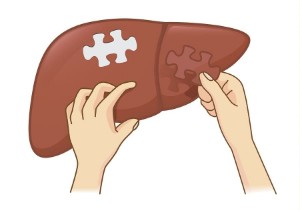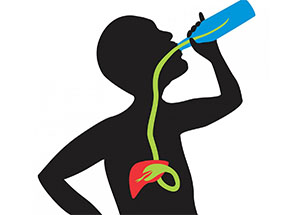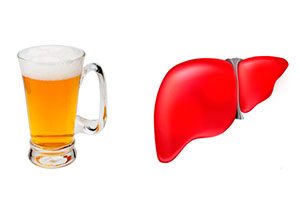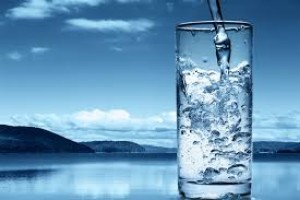What can and cannot be eaten on a diet &171;table No. 5&187; — table of products and menu for the week
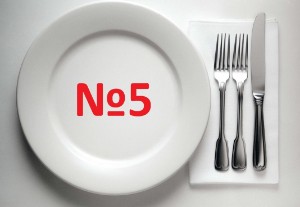 The diet "Table number 5" is a diet diet compiled by the Soviet therapist and scientist Manuel Isaakovich Pevsner. This diet is aimed at improving the functioning of the digestive system in acute and chronic diseases of the liver, gallbladder and biliary tract.
The diet "Table number 5" is a diet diet compiled by the Soviet therapist and scientist Manuel Isaakovich Pevsner. This diet is aimed at improving the functioning of the digestive system in acute and chronic diseases of the liver, gallbladder and biliary tract.
Western scientists also confirm that the inclusion of certain foods in the diet, as well as the exclusion of others, can really have a huge impact on the health of the digestive system.
In this article, we will comprehensively consider the therapeutic diet No. 5 according to Pevsner. We will describe the indications for its observance. We will provide lists of prohibited and permitted products. Let's tell you what effect it can have on various diseases of the liver and gastrointestinal tract.
Content
General information about diet No.5
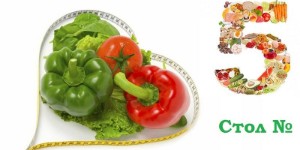 Manuel Isaakovich Pevsner is the founder of the so-called "gastronomic therapy" and dietetics in the USSR, a recognized honored scientist. His works are now widely used in the world of dietetics.
Manuel Isaakovich Pevsner is the founder of the so-called "gastronomic therapy" and dietetics in the USSR, a recognized honored scientist. His works are now widely used in the world of dietetics.
His main work is developing 15-and diets , aimed at the rehabilitation of the patient and treatment of acute and chronic diseases of the digestive tract. The diet number 5 is one of them.
Regarding this diet, it is designed for patients with diseases of the liver, gallbladder and biliary tract, who have impaired gastric juice synthesis, and also have liver malfunctions. In addition, this gentle diet is considered hypoallergenic.
Key aspects of this therapeutic diet:
- Minimal stress on the gastrointestinal tract and liver;
- Providing the body with the proper amount of proteins, fats and carbohydrates (with a total calorie content of about 2.4 thousand kilocalories);
- Inhibition of bile secretion (more precisely, reducing the need for its production, since "heavy" food is not included in the diet).
9 basic indications for its observance
The main indication for the diet number 5 &8212; is the need to reduce the amount of bile produced, as well as a decrease in the acidity of the stomach environment. Accordingly, it can be applied:

- For gastritis of any etiology. For a faster recovery of the gastric mucosa in gastritis, it is necessary to reduce the amount of gastric juice produced. This is the main effect of the diet in question.
- For pancreatitis. In addition to gastric juice, food is digested under the influence of special groups of enzymes that are synthesized in the pancreas. Pancreatitis is its inflammation. A faster recovery is possible with a reduction in the load on the gland, which is also provided by the diet table, since it includes only easily digestible foods.
- For liver diseases. Bile is synthesized in the liver from the so-called "bitter substances". Reducing the amount of bile produced is a reduction in the load on the organ, which is just necessary for faster treatment of cirrhosis of the liver, hepatitis, fatty hepatosis. It is not for nothing that this diet is also called "hepatic".
- For gastroduodenitis. This disease is an analogue of gastritis, which only develops already in the cavity of the duodenum. Again, the first stage of treatment is normalization of the pH level of the stomach environment. The Pevsner medical diet will also help in this.
- After removal of the gallbladder. After such an operation, bile enters the stomach cavity exclusively through the bile ducts. However, some time is needed for their formation and expansion. To normalize the patient's condition during this period, the diet described in the article is prescribed.
- For stomach ulcers. This disease occurs against the background of bacterial lesions of the gastric mucosa, which is subsequently complemented by the destructive effect of gastric juice on the inner walls, which are not hidden behind a layer of mucus. The Pevsner diet allows you to reduce acidity, thereby minimizing the negative effect of juice on the epithelium.
- After surgical treatment. The diet is prescribed to reduce the likelihood of intoxication, but with providing the body with the necessary daily portion of calories. All this will reduce the load on the gastrointestinal tract, accelerate recovery.
- In diseases of the pancreas. It is almost always necessary to inhibit and reduce the amount of enzymes produced. The Pevsner diet just includes only those foods for the digestion and assimilation of which the body consumes a minimum of energy and gastric juice, enzymes.
- To recover from prolonged alcohol abuse. It is known that alcohol has a detrimental effect on the liver and other organs of the gastrointestinal tract. The described diet can contribute, along with others methods of liver restoration in case of alcohol damage .
It should also be noted that this diet can be used in case of violation of the healthy balance of the intestinal microflora, if this is provoked by a weakening of the immune system or the predominance of protein, fatty foods in the diet.
This option is optimal if low–calorie diets are contraindicated to the patient for some reason (for example, if obesity is combined with severe pathologies of the cardiovascular system).
7 general rules of diet
The following list should be highlighted from the general rules of this diet:
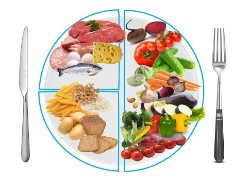
- You should eat at least 5 times a day, in small portions.
- It is necessary to eat every day at the same time (this is how the body "gets used" to produce bile and enzymes in a timely manner).
- Salt intake – no more than 10 grams per day, even better – up to 5 grams.
- Coarse fiber is banned.
- No more than 150 grams of food should be consumed at a time.
- It is necessary to refrain from eating too cold and too hot food (the ideal food temperature is close to 37 degrees).
- It is also important to drink a lot, at least 2 liters per day, to prevent constipation and intestinal obstruction.
- Follow the rules that relate to permitted and prohibited food. We will provide a ready-made menu for the week below.
Table of permitted and prohibited products
Observing a certain diet, it is very important to know what you can and cannot eat. According to the instructions of Manuel Pevsner himself, with the diet "table No. 5" it is necessary to adhere to the following table of division in food:
| Name | Permitted products | Prohibited products |
| Drinks | Not sweet black tea | Coffee |
| Broth of rosehip | Cocoa | |
| Decoction of non-acidic dried fruits | Green Tea | |
| Tea from pharmacy chamomile | Hot chocolate | |
| Various kinds of jelly (not sour, not dairy) | Sour juices and compotes | |
| Soups | Any, but only in vegetable broth | Soups with meat broth |
| Vegetable broths with cereals | Okroshka | |
| Porridge | Any frayed and viscous | Legumes |
| Cereal casseroles (without butter) | Pearl | |
| Yachnaya | ||
| Pasta | Low-fat pasta only | All other varieties of pasta are excluded, including egg noodles |
| Meat and fish products | Chicken breast (cook without butter) | Beef |
| Low-fat fish varieties | Pork | |
| Oysters | Oily fish (the same carp or salmon is banned) | |
| Shrimp | Grainy caviar (black and red too) | |
| Crab sticks (they are most often prepared from fatty fish, crabs or shrimps are not in them) |
Sample menu for the week
Manuel Pevsner compiled several variations of the daily diet, taking into account possible other diseases (not only the gastrointestinal tract, but also the cardiovascular system, for example). The "universal" option in this case will be the following menu for each day of the week (again, this is just an approximate menu, its final version must be coordinated with the attending physician):
| Meal | Monday | Tuesday | Wednesday | Thursday | Friday | Saturday | Sunday |
| Breakfast | Steamed chicken meatballs | Low-fat cottage cheese | Semolina porridge with a small amount of raisins | Cheesecakes with dried apricots | Egg white and vegetable omelet | Oatmeal with milk | Protein omelet with tomatoes |
| Lunch | Vegetable soup | Vegetable soup with any grated grits | Buckwheat soup and a small piece of low-fat boiled beef | Pumpkin porridge | Zucchini soup without meat and cottage cheese | Chicken cutlets, it is possible with vegetables from the allowed | Minced fish cutlets |
| Dinner | Beetroot salad and unsweetened tea | Baked apple and non-sour compote | Fish baked in sour cream | Boiled beetroot and cabbage salad (be sure to choose non-acidic varieties) | Vegetable casserole (make as a stew, but no meat at all) | Lean beef with milk sauce | Fish soup and dried fruits (as dessert) |
As for the portions, then the following daily allowance should be followed:
- 50 grams – proteins;
- 50 grams – fats;
- 400 grams – carbohydrates.
The total daily nutritional value should be about 2.4 thousand calories. In case of obesity, it is reduced to about 1.8 thousand calories. Again, you should always follow the instructions of the attending physician, who can visually assess the patient's condition and make up the best diet option for him.
7 suitable recipes for every day
Diet number 5 is not strict. Many of the dietary dishes, including those listed above in the table, are quite tasty. But you can always diversify your diet with the same chicken souffle or vegetable pastries, beetroot sweet salad. Since the diet involves eating at least 5 meals a day, all these dishes are suitable for the first and second afternoon tea.
Below we will look at 7 recipes that are perfect for the &171;fifth table&187;.
1. Carrot Soup
Such a soup is prepared without meat at all, you can't even cook bones.
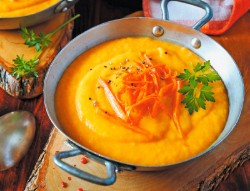 Cooking will require:
Cooking will require:
- 0.5 kilograms of carrots cut into cubes;
- Chop 1 medium onion;
- Stew all this in a small amount of vegetable oil (you can also add literally 0.5 teaspoons of butter for flavor);
- After 4-5 minutes – add a little salt, a small pinch of dry ginger (seasoning);
- Then use a blender to bring it all down to a puree state;
- Pour in water and cook for 25-30 minutes;
- Before serving, you can decorate with sprigs of greens (not sour).
This carrot puree soup belongs to the diet, it is perfect for both lunch and dinner.
Various forums also assure that it turns out quite tasty if you add a few chicken cubes to such a soup. Doctors strongly recommend against using such "broths" due to the presence of dyes and flavorings in their composition.
2. Chicken souffle

Necessary ingredients:
- 200 grams of fresh cabbage;
- 1 medium onion head;
- 150 grams of carrots;
- 700 grams of chicken fillet;
- 2 chicken eggs (whites only);
- Some greens (to taste, not sour);
- 0.5 cups of low-fat milk;
- Salt, ground pepper;
- Vegetable oil;
A dietary chicken souffle is prepared in this way:
- Thoroughly wash cabbage, onions and carrots, peel and cut into small pieces.
- Finely chop the greens and chicken fillet.
- Put all this in a blender, add egg whites, chop.
- Last of all, add salt to taste, you can add just a little pepper (preferably white), add about 0.5 cups of low–fat milk.
- Beat everything again with a blender.
- Next, grease the baking molds with vegetable oil, spread the resulting souffle over them and bake at 180 degrees until ready (about 30 minutes).
- Before serving, decorate with olives or herbs.
3. Carrot puree
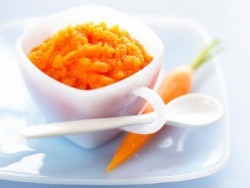 To make mashed potatoes, you will need:
To make mashed potatoes, you will need:
- 400 grams of carrots;
- 400 grams of apples;
- 100 grams of asparagus;
- Half a cup of low-fat milk.
Cooking process:
- Wash and peel the carrots, put them to boil, bring to a boil and cook over low heat for 10 minutes.
- Peel the apples, cut out the core along with the bones, chop into cubes.
- Put the already soft carrots and apples in a bowl, chop with a blender.
- To taste, you can add asparagus or low–fat milk (until a puree-like mixture is obtained).
You can also add powdered sugar to taste and non-acidic dried fruits - you will get a very nutritious, but at the same time "light" dessert.
4. Oatmeal soup
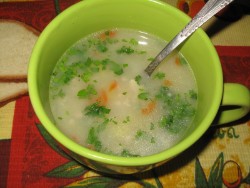 Such oatmeal soup is also called &171;slimy &187;, because due to its consistency, it literally &171; envelops &187; the walls of the stomach.
Such oatmeal soup is also called &171;slimy &187;, because due to its consistency, it literally &171; envelops &187; the walls of the stomach.
Ingredients:
- 200 grams of potatoes;
- 200 grams of oat flakes;
- Dill, parsley, onion, carrot &8212; to taste.
It is prepared like this:
- Put the potatoes in cold water, add salt to taste, and cook over low heat.
- After 10 minutes, remove the foam, add the oat flakes, continue cooking for another 10 minutes (it may take several more times to remove the foam).
- Add dill, parsley, onion, boiled carrots – everything to taste.
5. Diet pudding
It is best to cook cottage cheese diet pudding – it turns out delicious, nutritious, and at the same time, cottage cheese (be sure to use low-fat) contains a large amount of easily digestible protein.
 Cooking will require:
Cooking will require:
- 120 grams of low-fat cottage cheese;
- 60 milliliters of skimmed milk;
- 10 grams of semolina;
- 1 egg white;
- 2 teaspoons powdered sugar;
- 3-5 grams of butter.
Cooking process:
- All ingredients are mixed in one bowl, thoroughly whipped with a powerful mixer or blender.
- Then it remains only to grease the baking dish and put the pudding in the oven for 10-15 minutes at 180 degrees.
6. Buckwheat and rice pancakes
The most difficult thing is to follow a baking diet – you have to almost completely abandon it. The exception is dietary biscuits (which are prepared without margarine, but they can hardly be called tasty). A great alternative is buckwheat and rice pancakes.
 To cook them, you need:
To cook them, you need:
- 1 cup of boiled rice;
- 3 tablespoons buckwheat porridge;
- 2 eggs;
- A third of a cup of flour;
- 1 teaspoon of sugar;
- A pinch of salt;
- 1 tbsp vegetable oil.
It is prepared like this:
- All ingredients are mixed, ground with a blender until puree is obtained.
- Then baking paper is covered on a baking sheet, greased with vegetable or butter, future pancakes are laid out on it.
- Bake at 180 degrees for about 15-20 minutes.
7. Pumpkin and beetroot salad
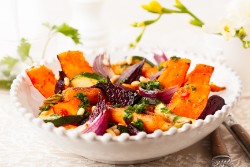 Will require:
Will require:
- 200 grams of pumpkin;
- 2 beets;
- 1 teaspoon of liquid honey (can be replaced with sugar syrup);
- Salt and pepper to taste.
We cook this way:
- Cut the pumpkin into cubes and bake on parchment for 30 minutes at a temperature of 160 – 180 degrees.
- Boil the beetroot and grate it on a coarse grater.
- Put all this in an enameled bowl, add honey or syrup, mix thoroughly. You can also add dried fruits, raisins.
- Add salt and a small pinch of pepper to taste.
For those who do not like sweet salads, honey is replaced with olive oil.
Compliance features for children
The doctor can prescribe the diet number 5 even to those children who have just recently completed the introduction of complementary foods. Often at such a young age, due to an initially incorrectly selected diet or abuse of mixtures, problems arise in the work of the gastrointestinal tract, up to the suspicion of various forms of gastritis. The key features of the prescribed diet for a child are the same as for adults.
There are only a few differences:
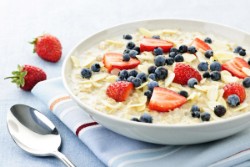
- At one meal, eat no more than 100 grams (including the drink – no more than 300 grams);
- Rice is always preferred from cereals, only pearl barley can be prepared from milk porridges;
- Of meat products – only fish (even low-fat chicken breast should not be used);
- Milk – as much as possible, but only low-fat;
- It is also necessary to give low-fat sour cream at least 1 time a day;
- Eat at least 100 grams of fresh fruit daily (not sour).
Related videos
And now we invite you to familiarize yourself with the video:
;
Conclusion
In total, the "fifth table" is suitable for those who need a gentle diet, but at the same time avoiding stagnation of bile. This diet is universal, suitable for almost any diseases of the gastrointestinal tract, including obesity. Its observance will help to normalize the health of a person suffering from these diseases.

